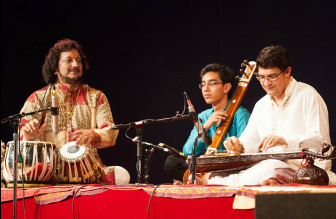
By TSR KRISHNAN
TUSTIN, CA - Chinmaya Mission Los Angeles, through its cultural arm, Kalanjali hosted a musical evening in the expansive auditorium at their center ‘Rameshwaram’ on Aug. 23. The memorable Hindustani musical event came via a 90-minute performance by Suman Laha on vichitra veena accompanied by...
TUSTIN, CA - Chinmaya Mission Los Angeles, through its cultural arm, Kalanjali hosted a musical evening in the expansive auditorium at their center ‘Rameshwaram’ on Aug. 23. The memorable Hindustani musical event came via a 90-minute performance by Suman Laha on vichitra veena accompanied by...
the legendary tabla maestro, Pandit Kumar Bose; followed by a mesmerizing hour long percussion solo by him accompanied by Rupesh Kotecha on the harmonium.
Laha, who is the teacher –director of Cerritos Music Circle, played on his own uniquely designed version of Vichitra Veena. He has received his training from the Senia purist Pt. Shyamal Chattopadhyay, from the lineage of Mian Tan Sen. His alap in purya dhanasree, an evening raga, was an exquisitely balanced synthesis of traditional music and modern musical expression.
His control and mastery of the instrument was evident when he followed his solo alap in dhrupad style to a fast tempo drut before Pandit Kumar Bose entered the stage to accompany him on his vilambit pallavi. Suman concluded his short concert with a short composition in raag hindol with quick phrases ably answered by the tabla maestro.
Tabla legend Pt Bose started his center stage expose with a short introduction of his journey into the world of music and his deep appreciation of the instrument of his choice. Bose has mastered the instrument over the past four decades of performing life bringing out the best of expressive tonal inflections and melodic nuances. The musician was groomed as a youngster by the late Pandit Ravi Shankar to be more expressive and expansive in his accompaniment resulting in ground breaking experimentations.
Bose is also the most established disciple of the legendary Pandit Kishan Maharaj, belonging to the Benares school. His tabla solo was characterized by skillful play between the two drums (tabla and the bayan). He is especially unique amidst tabla players that he plays the usually right drum with his left hand and the left with his right hand, which in itself was a pleasure to watch.
Throughout the performance, he kept announcing his compositions exquisitely in “bols”; often, he recited some of the rarest taranas of bols with interludes of anecdotal Sanskrit verses. The maestro demonstrated, as to how the intonations and subtle modulations start in gentle cyclic pairs, quartet, sextet and octet of ‘thekas’ and then race in intensity to complex mathematical variations peaking to a crescendo when the fingers on the drums were no longer ‘visible’ to the onlooker, but were simply heard and felt. It was also evident from Kumar Bose’s scholarly references that most of these compositions have been written to accompany Kathak dancers and are a specialty of the Benares tradition, which Kumar Bose ably represents.
When the performance ended, the devout fan crowd exploded in to a standing ovation and wished that it never ended.
Laha, who is the teacher –director of Cerritos Music Circle, played on his own uniquely designed version of Vichitra Veena. He has received his training from the Senia purist Pt. Shyamal Chattopadhyay, from the lineage of Mian Tan Sen. His alap in purya dhanasree, an evening raga, was an exquisitely balanced synthesis of traditional music and modern musical expression.
His control and mastery of the instrument was evident when he followed his solo alap in dhrupad style to a fast tempo drut before Pandit Kumar Bose entered the stage to accompany him on his vilambit pallavi. Suman concluded his short concert with a short composition in raag hindol with quick phrases ably answered by the tabla maestro.
Tabla legend Pt Bose started his center stage expose with a short introduction of his journey into the world of music and his deep appreciation of the instrument of his choice. Bose has mastered the instrument over the past four decades of performing life bringing out the best of expressive tonal inflections and melodic nuances. The musician was groomed as a youngster by the late Pandit Ravi Shankar to be more expressive and expansive in his accompaniment resulting in ground breaking experimentations.
Bose is also the most established disciple of the legendary Pandit Kishan Maharaj, belonging to the Benares school. His tabla solo was characterized by skillful play between the two drums (tabla and the bayan). He is especially unique amidst tabla players that he plays the usually right drum with his left hand and the left with his right hand, which in itself was a pleasure to watch.
Throughout the performance, he kept announcing his compositions exquisitely in “bols”; often, he recited some of the rarest taranas of bols with interludes of anecdotal Sanskrit verses. The maestro demonstrated, as to how the intonations and subtle modulations start in gentle cyclic pairs, quartet, sextet and octet of ‘thekas’ and then race in intensity to complex mathematical variations peaking to a crescendo when the fingers on the drums were no longer ‘visible’ to the onlooker, but were simply heard and felt. It was also evident from Kumar Bose’s scholarly references that most of these compositions have been written to accompany Kathak dancers and are a specialty of the Benares tradition, which Kumar Bose ably represents.
When the performance ended, the devout fan crowd exploded in to a standing ovation and wished that it never ended.



 RSS Feed
RSS Feed
